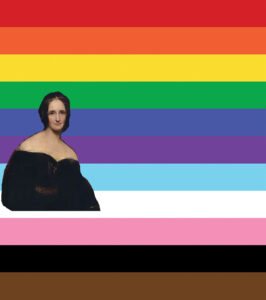Tuesday, September 24, 2024

Mary Shelley, the iconic author of
Frankenstein holds a prominent place in literary history, not only as the mother of science fiction but also as a figure whose life and works resonate with LGBTQAI+ themes and issues. Though Shelley lived in the 19th century, long before modern conceptions of gender and sexuality, her writings and personal life reveal an intricate relationship with ideas that align with contemporary discussions of queerness, identity, and non-normativity.In this blog, we will explore Mary Shelley’s legacy through a queer lens—examining her life, friendships, and the underlying queer themes in her work that continue to resonate with LGBTQAI+ audiences today.
The Queer World of Mary Shelley’s Life
Mary Shelley, born in 1797, was no stranger to unconventional and radical ideas. Her parents, Mary Wollstonecraft (a pioneering feminist) and William Godwin (a political philosopher), instilled in her a sense of intellectual freedom that challenged societal norms. These progressive foundations influenced not only her politics but also her approach to personal relationships.
Her relationship with the poet Percy Bysshe Shelley, whom she married, was unconventional for the time. Percy had radical views on free love and polyamory, and their marriage was often marked by non-monogamous tendencies. This openness to alternative relationship structures mirrors contemporary discussions about queerness and fluidity in love.
Additionally, Mary Shelley’s social circle included a number of queer figures, such as Lord Byron, who was openly bisexual, and possibly others who expressed fluid desires and identities. Living in such an environment exposed Shelley to ideas that pushed against rigid gender roles and heteronormativity. This atmosphere may have informed the complex gender dynamics in her work, especially Frankenstein.
Frankenstein: A Queer Text?
Frankenstein, written when Shelley was just 18, has often been interpreted as a story laden with queer subtext. At its core, Frankenstein explores themes of creation, isolation, and otherness—issues that resonate deeply with LGBTQAI+ experiences.
Gender and Creation
In Frankenstein, Victor Frankenstein usurps the role traditionally associated with women: that of giving birth. Victor’s desire to create life without a woman—bypassing traditional procreation—can be seen as a transgression of natural gender roles. His obsession with creating a new life without sexual reproduction may reflect an anxiety about gender norms and the natural order of things, ideas that resonate with contemporary queer theory.
The Creature as a Queer Other
The Creature in *Frankenstein* can also be read as a metaphor for queer identity. Cast out by society, misunderstood, and forced to live on the margins, the Creature’s experience mirrors the historical treatment of LGBTQAI+ individuals. Just as the Creature longs for companionship and acceptance, so too have queer individuals throughout history faced isolation and persecution due to their otherness.
Furthermore, the Creature’s inability to find a mate—paralleling the societal rejection of non-heteronormative relationships—underscores his role as an outcast. His existence challenges the boundaries of what is considered “normal” or “natural,” themes deeply connected to the queer experience.
Queerness in the Gothic Tradition
Mary Shelley’s work exists within the Gothic tradition, which has long been a space for exploring repressed desires, unconventional identities, and the darker sides of human experience. Many Gothic texts can be interpreted as queer, with their focus on transgression, boundary-crossing, and the exploration of taboo subjects. In *Frankenstein*, as well as in later Gothic novels, there is often a fascination with characters who live on the fringes of society, much like queer individuals have historically existed on the margins.
This exploration of repressed or hidden identities is part of what makes *Frankenstein* such a powerful queer text. The novel’s treatment of isolation, difference, and the fear of the “Other” can be read as a reflection of the societal pressures faced by LGBTQAI+ people.
Legacy: Mary Shelley and the LGBTQAI+ Community Today
Though Mary Shelley herself might not have explicitly identified with any contemporary LGBTQAI+ labels, her life and work continue to resonate deeply with the queer community. *Frankenstein* remains a text that invites readings about identity, otherness, and the fluid nature of gender and desire. It challenges the boundaries between “normal” and “abnormal,” “natural” and “unnatural,” in ways that parallel queer theory’s critiques of binary thinking about sex, gender, and sexuality.
Moreover, the open and non-traditional relationships she maintained, the radical social circles she moved in, and her fascination with themes of creation and identity make Mary Shelley an enduring figure for queer readers. Her work offers a rich field for exploring the complexities of identity, marginalization, and the human longing for connection, all of which resonate with LGBTQAI+ individuals today.
Queering Mary Shelley
Mary Shelley, though writing in the early 19th century, offers a unique voice in discussions of queer literature. Her life and works engage with issues of identity, difference, and non-conformity in ways that align with contemporary LGBTQAI+ concerns. In *Frankenstein* especially, she provides a narrative that speaks to the isolation, alienation, and societal rejection often experienced by queer individuals.
In exploring Mary Shelley’s life and work through a queer lens, we discover a writer whose themes of creation, otherness, and the boundaries of identity remain strikingly relevant in our modern conversations about LGBTQAI+ issues. Whether through the lens of queer theory or simply as a literary ally, Mary Shelley’s contribution to the ongoing dialogue about identity and difference is undeniable, and her legacy continues to inspire new generations of queer readers and writers alike.
**This blog aims to highlight the connections between Shelley’s life, her literary contributions, and how her themes resonate with LGBTQAI+ experiences, offering a nuanced understanding of her lasting influence.